Fresh, straightforward meals are key for older dogs. This guide combines vet-approved recipes with useful tips. Now, you can easily make meals that support their health. Aim for a diet that helps muscles, joints, and digestion. And keep an eye on calorie intake.
Lean proteins, colorful veggies, and foods rich in water are best for senior dogs. What’s most important? Hydration, easy digestion, and meal safety. Discover recipes that use real foods, simple steps, and smart additives. This ensures every meal is both complete and nourishing.
Get ready for recipes from turkey and brown rice to mild venison dishes. Plus, learn about superfoods like fish oil, broccoli, and carrots. They enhance brain and joint health. Tips on portion sizes, storage, and cleanliness are part of the deal for daily wins.
All recipes are vet-backed. They guide you to tailor proteins, carbohydrates, and fats for your dog’s needs. Whether it’s managing weight, boosting energy, or improving comfort, the right food plan helps. And it’s possible to serve healthy, home-cooked meals for your senior dog without breaking the bank.
Why Senior Dogs Need a Different Diet for Their Golden Years
As dogs age, they move less and need fewer calories. Their diet should adapt to slower metabolisms. Adjusting meal portions and ingredients can keep their energy even and their joints happy.
Slower metabolism and calorie adjustments to prevent obesity
Older dogs use up fewer calories when resting. Keeping them from getting overweight is important. Start with food amounts that fit their weight and shape, then tweak as needed.
Homemade meals can be lighter than dry dog food, helping them stay full on fewer calories. Split their daily food into two portions, with a bigger meal in the morning and a smaller one at night.
Higher protein needs to preserve lean muscle mass
As dogs get older, they can lose muscle. Eating more protein helps them stay strong and move easily. Choose foods like turkey, chicken, eggs, or fish for high-quality protein.
This not only keeps their muscles strong but also keeps them feeling full, which might cut down on begging for snacks.
Lower to moderate carbohydrates to support healthy weight and pancreas function
Senior dogs do better with less carbs in their diet. Choose lighter carbs like oats, rice, or sweet potatoes. Adding veggies can help keep their energy up without adding too many calories.
This helps their stools stay regular, too.
Hydration benefits of fresh, high-moisture homemade meals versus kibble
Older dogs often drink less water. Feeding them wetter foods can help keep them hydrated. Fresh, moist meals can support their joints, kidneys, and digestion better than dry food.
For extra hydration, include broths or steamed veggies that are low in salt and sugar.
Essential Nutrients Older Dogs Can’t Miss
Older dogs need balanced meals for good health. Key nutrients support their muscles, joints, brain, and digestion. The goal is clear: use real foods, make wise additions, and follow a consistent routine.
High-quality, highly digestible protein and essential amino acids
The quality of protein is crucial. Opt for turkey, chicken, fish, venison, and a bit of organ meats. These provide the amino acids needed to keep muscles strong. Turkey is especially good because it’s easy on the stomach and offers taurine and L-carnitine. Both are vital for the heart and energy levels.
Cook the protein lightly to make it easier to digest. Make sure it’s moist so seniors can chew without trouble. Regular protein intake helps them stay mobile and lively.
Healthy fats and omega-3 fatty acids for brain, joints, and skin
Fats are important for older dogs, making their coats smooth. Include fish oil for omega-3 DHA, which supports memory, joint flexibility, and skin health. Wild-caught salmon oil is a great choice alongside lean meats and veggies.
Control the fat portions. A small amount is enough to prevent extra calories while keeping their coat shiny and healthy.
Fiber for digestion, regularity, and satiety
Feed them colorful veggies like carrots, peas, green beans, and cruciferous ones for fiber. It helps with digestion and keeps them feeling full. It also prevents begging and ensures regular bowel movements.
Steam and chop the veggies well to improve digestion. A stable mix of fiber can reduce stomach issues.
Key vitamins and minerals: calcium, magnesium, potassium, zinc, selenium
Vitamins and minerals are crucial for strong bones and smooth nerve function. Get calcium from eggshell powder or citrate for bone and muscle health. Magnesium supports energy levels, and potassium from foods like sweet potatoes helps with heart and fluid balance.
Zinc and selenium strengthen the immune system and improve coat quality. Many choose premixes to ensure these nutrients are included in every meal.
Antioxidants from colorful produce to support cognitive and immune health
Add colorful fruits and veggies for antioxidants. They support brain health and fight aging effects. Include blueberries, spinach, and squash for flavor and health benefits.
Combine these with lean proteins and healthy fats for well-rounded meals. It ensures all essential nutrients are included without overfeeding.
A recap: Include amino acids from clean proteins, omega-3 DHA from quality oils, fiber from gentle veggies, and essential vitamins from whole foods. Don’t forget about taurine and L-carnitine for the heart and energy levels.
Vet-Approved Homemade Food Recipes
These meals are easy to make and great for older pets. Each recipe can be made in big batches, freezes well, and is easy on older pets’ stomachs. They also taste great.
Superfood turkey and brown rice with blueberries, carrots, and broccoli
Start with lean ground turkey cooked in a bit of coconut oil. Add steamed carrots and broccoli. Then mix in lightly crushed fresh blueberries for a dish full of color and health benefits. Cook the brown rice until it’s soft. Mix everything together and add fish oil and Holistic Vet Blend premix to complete the nutrients.
Divide it into servings for 3–5 days and freeze any extra. This mix is good for their joints and brain. The Holistic Vet Blend premix ensures each batch is nutritionally consistent.
Lean venison with sweet potatoes and mixed cruciferous vegetables
If poultry isn’t a good fit, try this venison recipe. Cook the venison with sweet potatoes and a touch of rosemary until it’s tender. Then, add broccoli, cauliflower, and carrots for a gentle mix. This broth is light and easy for seniors to eat.
Choosing venison provides a lean protein source that’s good for sensitive dogs. Once it’s cool, portion it out and freeze. This keeps the meals easy to serve and simple for dogs with sensitive stomachs.
Customizable meat-veg-carb bowl with eggshell calcium
Make a custom bowl by cooking any boneless meat with coconut oil and turmeric. Mix in soft veggies and cooled complex carbs like brown rice or oats. Add finely ground eggshell calcium to ensure they get this important nutrient.
This approach keeps the food moist for older dogs. Change up the ingredients to keep your pet interested. It’s an easy way to make pet food that stores well.
When and how to add dog-specific premixes or supplements for balance
Add special premixes like Holistic Vet Blend to make sure your pet’s diet is complete. These blends add essential vitamins and minerals. Supplements can also help with joint, brain, and skin health. Make sure they fit with the main parts of the diet.
Add these mixes when the food is cool. Mix them in well to make sure your pet eats all parts of their meal. Talk with a vet or nutritionist to make sure the diet fits your pet’s needs.
Ingredient Spotlight: Superfoods That Support Aging Dogs
Small, smart updates to homemade meals benefit older dogs. These senior dog superfoods are perfect for daily use. They boost energy, improve mobility, and keep focus sharp. Plus, they’re easy to find in the U.S. and simple to prepare.
Blueberries for antioxidants and brain health
Choose fresh or frozen blueberries for your dog and crush them lightly. The crushed skins help with digestion and release antioxidants. These fight harmful free radicals. Adding them regularly supports cognitive health, especially when combined with DHA.
Try adding a spoonful to their breakfast. Or mix into cooled turkey and rice dishes. Their tart taste goes well with bland meats. Plus, the color hints at healthy polyphenols.
Broccoli and carrots for vitamins, minerals, fiber, and sulforaphane
Steam broccoli and carrot pieces until they’re just right. Broccoli offers sulforaphane, aiding cell defense, while carrots add fiber and vitamin A. This helps with regularity and supports vision.
Give them in small amounts to prevent gas. And make sure they’re cool before serving. Chopping or pureeing makes them easier for senior dogs to eat.
Turkey as a lean, digestible protein rich in taurine
Pick ground turkey for a soft protein that’s easy on older stomachs. It’s packed with taurine, supporting muscle, heart, and vision health.
Cook it lightly, then add crushed berries for a nutritious meal. Keep the pieces small for easy eating.
Healthy oils: fish oil and coconut oil for omega-3s and energy
Introduce fish oil to your dog’s diet for EPA and DHA. This supports brain health, joint comfort, and shiny fur. Start with a small dose, checking labels from brands like Nordic Naturals or Nutramax.
Coconut oil offers quick energy and is great for light cooking. Use it sparingly to sauté veggies or turkey. Then cool it down before serving to keep the fats healthy.
Add a pinch of turmeric for extra flavor and health benefits. Consider supplements like Critical Immune Defense or SeniLife as recommended by your vet.
Preparation, Cooking, and Food Safety for Maximum Nutrition
Using smart techniques can help keep nutrients in dog food. These methods are all about gentle cooking, exact measurements, and clean handling. They help make sure every meal is full of energy and easy for dogs to digest.
Steaming vegetables and gentle cooking to retain nutrients
Steaming veggies for 8–10 minutes helps them keep their vitamins. They should look brighter and feel tender but not too soft. For better nutrition, lightly prepare carrots, broccoli, and greens before feeding.
Proteins do best with low to medium heat. This way, meat stays moist and easy for older dogs to digest. It’s a careful balance to keep meals nutritious and tasty.
Proper doneness to reduce pathogens while preserving digestibility
Using a digital thermometer ensures dog food is cooked safely. Make sure poultry is well done, and ground meats are cooked all through. Remember, overcooking can remove important nutrients.
When cooking, small batches are better. They allow you to mix the food properly. This keeps meals safe for pets and soft enough for senior dogs to eat.
Chopping, grinding, or pureeing for seniors with dental issues
Adjust meal textures for older dogs. You can chop, grind, or blend food to make it smooth. Use a food processor to mix meat, grains, and vegetables into a single dish that’s easy to eat.
If necessary, add a little warm broth to make the meal the right consistency. Keeping pieces tiny helps prevent choking and ensures dogs get all their nutrients.
Kitchen hygiene, measuring by weight, and thorough mixing
Create a clean space for meal prep away from harmful foods. It’s crucial to wash up and keep raw and cooked foods separate. Use a kitchen scale for precise ingredient amounts.
Even mixing ensures each bite of food is balanced. This avoids picky eating and guarantees dogs get the nutrition they need every day.
Before storing dog meals, cool them down. Keep food in the fridge for up to 5 days in sealed containers. Freezing can keep food fresh for two months. Label each batch with the freeze date.
Never leave food out too long. Thaw meals in the fridge and stir before serving to keep the food uniform.
Personalizing Meals: Health Conditions, Portions, and Transitions
Every senior dog has unique needs. Their meals should fit their age, how much they move, and health concerns. It’s key to manage their weight with lean proteins, enough carbs, and veggies rich in fiber. For easy digestion, choose wet food and add dog-specific supplements like Balance IT Canine or Holistic Vet Blend.
Adjusting recipes for weight control, sensitive stomachs, and allergies
To control weight, use turkey or venison. Add greens and limit starches. This keeps your senior dog’s weight in check and meals enjoyable. For allergies, avoid chicken, beef, wheat, soy, and dairy. Instead, go for sweet potatoes and greens like broccoli.
With a sensitive stomach, choose easy-to-digest recipes. Slow-cooked venison, mashed sweet potatoes, and finely cut broccoli work well. Keep spices simple and blend the food for dogs with teeth issues.
Special considerations for kidney concerns and phosphorus moderation
If dealing with kidney issues, talk to your vet about a low-phosphorus diet. Cut back on organ meats, fish, and dairy. Use calcium sources like eggshell powder or calcium citrate if needed. For kidney health, also adjust protein and sodium as per vet advice.
Portion guidance, meal timing, and weekly weight/body condition tracking
Begin with 2–4% of the dog’s body weight in food each day. Then, adjust based on your vet’s advice on calories. For example, a 15‑lb dog might eat 300 g daily (about 443 kcal). Alter this by 25% depending on their activity and health.
Give a bigger breakfast than dinner for consistent energy. Combine this with weekly weigh-ins and body checks. Look for changes in their ribs, waist, stamina, or appetite. Adjust food amounts quickly based on these observations.
Gradual transitions and monitoring stool, appetite, and energy
Switch to home-cooked meals gradually over 7–14 days, adding more new food at each meal. Monitor their stools, hunger, and energy. If you see vomiting, diarrhea, or itching, stop and rethink the ingredients and food texture.
Wet food helps keep dogs who don’t drink enough hydrated. Always have fresh water available, and add bone-free broth as needed. By regularly checking and adjusting, you can ensure meals remain appealing and gentle on their stomach.
Conclusion
Older dogs do well with simple, fresh meals. These meals should have easy-to-digest protein, moderate carbs, and healthy fats. Include fiber for digestion and omega-3s for their brain and joints.
Adding tasty lean meats like turkey and venison with vibrant veggies is great. Use blueberries, broccoli, carrots, and sweet potatoes for top-notch nutrition. Fill any nutritional gaps with dog-specific premixes and reliable calcium sources like Balance IT Canine, Holistic Vet Blend Canine Regular Premix, crushed eggshell, or calcium citrate.
Always prioritize safety: steam veggies, fully cook meats, and puree for ease of eating. Weigh and mix ingredients well for consistent meals. Cater to special health needs like kidney issues by adjusting phosphorus levels and tweak recipes for any allergies or sensitivities.
Success comes from following a set routine and seeking guidance. Partner with a vet or a certified nutritionist. Slowly switch diets, and monitor your dog’s weight and health regularly.
With the right habits and expert advice, vet-recommended recipes can boost a senior dog’s life. They can help maintain mobility, encourage eating, and make the later years joyful. Feeding your dog these superfoods supports both their physical health and their happiness.


























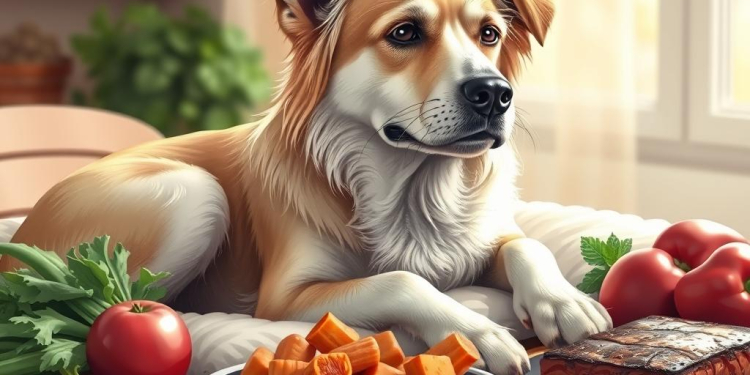







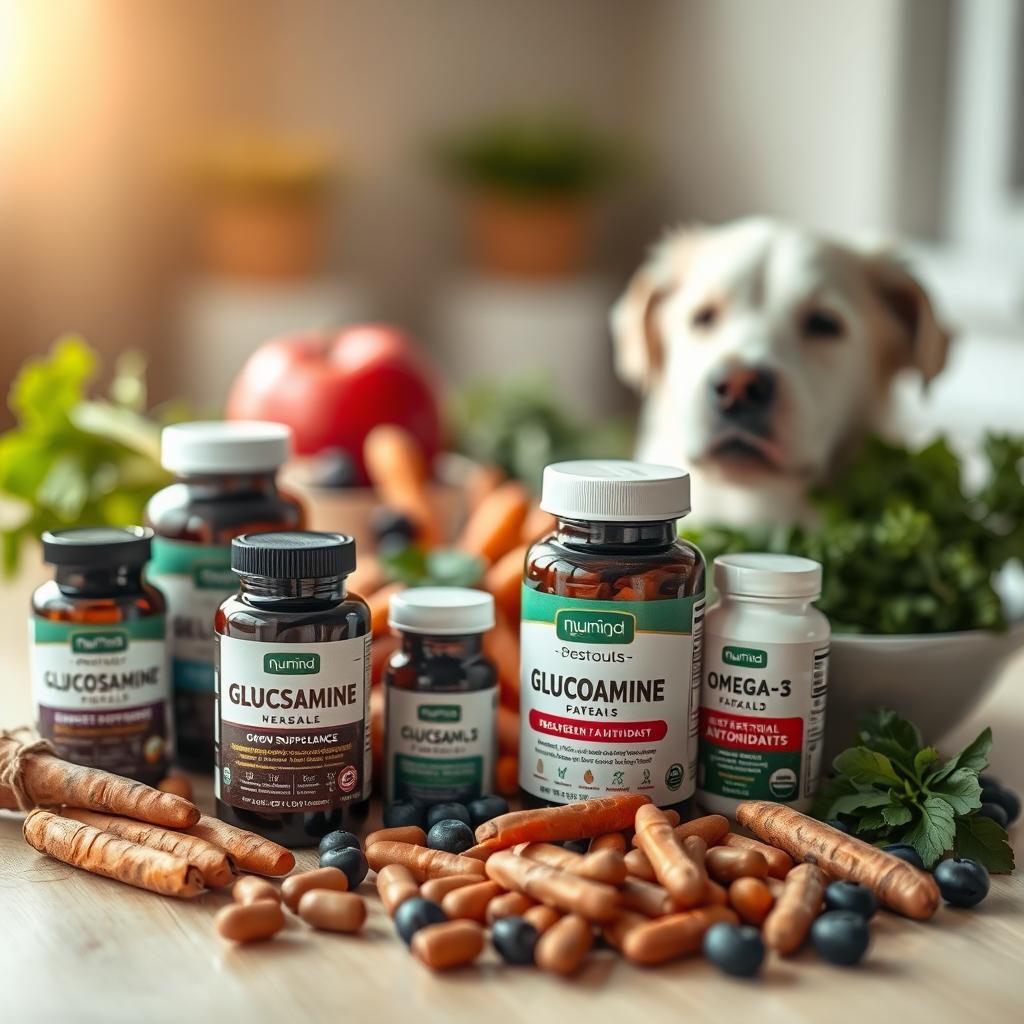
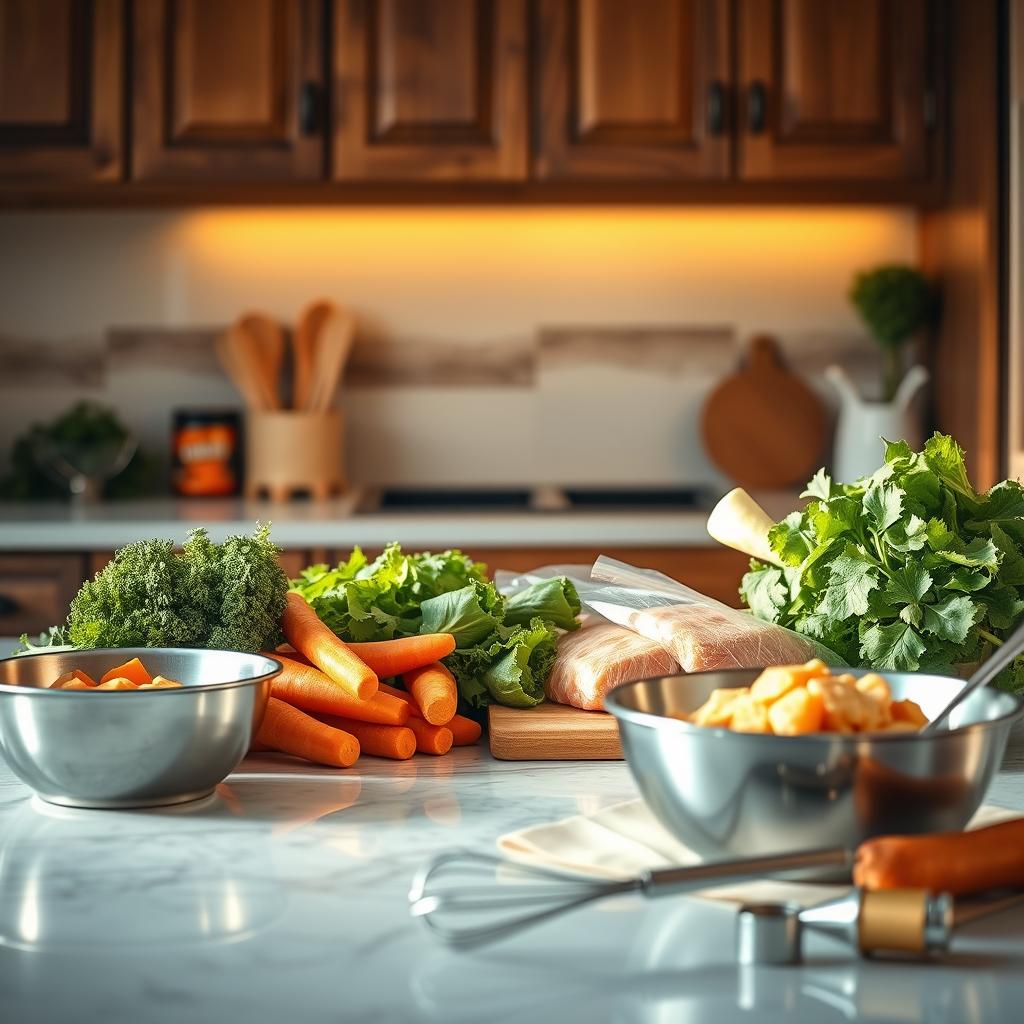

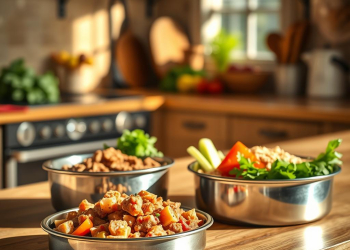
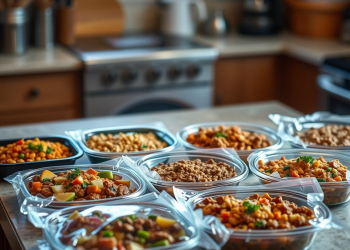
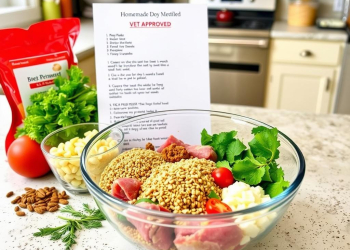
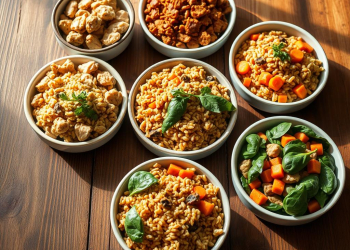










Discussion about this post